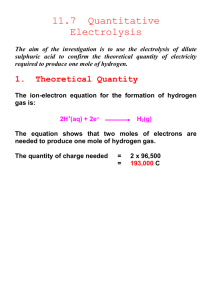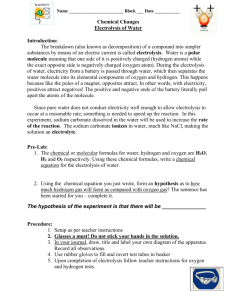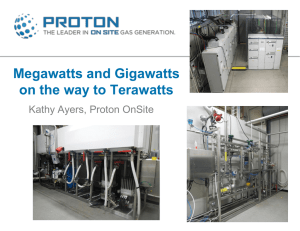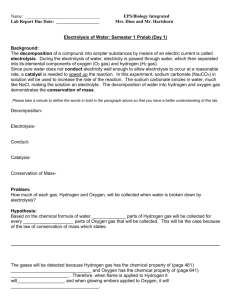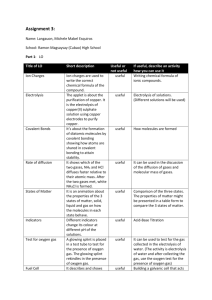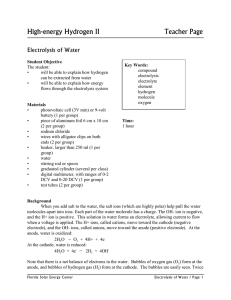Solar Matters III Teacher Page Electrolysis of Water
advertisement
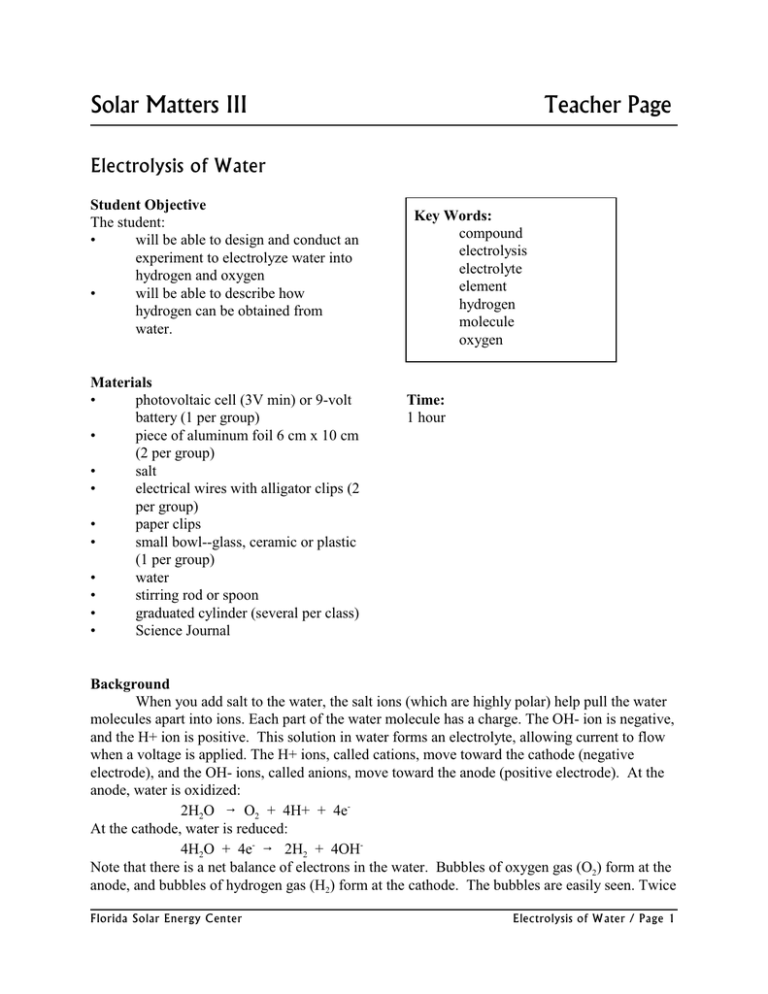
Solar Matters III Teacher Page Electrolysis of Water Student Objective The student: • will be able to design and conduct an experiment to electrolyze water into hydrogen and oxygen • will be able to describe how hydrogen can be obtained from water. Materials • photovoltaic cell (3V min) or 9-volt battery (1 per group) • piece of aluminum foil 6 cm x 10 cm (2 per group) • salt • electrical wires with alligator clips (2 per group) • paper clips • small bowl--glass, ceramic or plastic (1 per group) • water • stirring rod or spoon • graduated cylinder (several per class) • Science Journal Key Words: compound electrolysis electrolyte element hydrogen molecule oxygen Time: 1 hour Background When you add salt to the water, the salt ions (which are highly polar) help pull the water molecules apart into ions. Each part of the water molecule has a charge. The OH- ion is negative, and the H+ ion is positive. This solution in water forms an electrolyte, allowing current to flow when a voltage is applied. The H+ ions, called cations, move toward the cathode (negative electrode), and the OH- ions, called anions, move toward the anode (positive electrode). At the anode, water is oxidized: 2H2O 6 O2 + 4H+ + 4eAt the cathode, water is reduced: 4H2O + 4e- 6 2H2 + 4OHNote that there is a net balance of electrons in the water. Bubbles of oxygen gas (O2) form at the anode, and bubbles of hydrogen gas (H2) form at the cathode. The bubbles are easily seen. Twice Florida Solar Energy Center Electrolysis of W ater / Page 1 as much hydrogen gas is produced as oxygen gas. The net reaction: 2H2O 6 2H2 + O2 Procedure 1. Read the following passage to the students (This passage also appears in the student's Science Journal): Electrolysis is a technique used by scientists to separate a compound or molecule into its component parts. By adding electricity to a liquid and providing a path for the different particles to follow, a liquid can be separated into its component parts–using electrolysis, water can be separated into hydrogen and oxygen. In this experiment you will be taking a sample of salt water and adding a flow of electricity to it (electrolysis). You will see the hydrogen and oxygen bubbling up. 2. 3. 4. 5 Divide the students into lab groups of 3 - 4 students per group. Inform the students that the directions for this lab are in their Science Journal. They are to follow the directions, perform the lab, and complete the questions in their journals. Assist students as needed during the experiment. Lead a discussion on what the students observed and the significance of their observations. Points to cover may include: • electrolysis produced a chemical change (contrast to a physical change if this hasn’t been taught yet) • the chemical formula for water is H2O--two atoms of hydrogen to every atom of oxygen • the energy flow in this system. Energy cannot be created or destroyed....so where did the electrical energy go? The electrical energy is transformed into chemical energy that splits the molecules apart. • if you left this apparatus working long enough, it would heat up the water. Why? No energy conversion is 100% efficient–some energy is transformed to heat. • the process can be reversed using a fuel cell–hydrogen and oxygen are combined to make electricity and water • hydrogen is used as a combustible fuel on the Space Shuttle and can also be used to make electricity with a fuel cell • hydrogen is a renewable resource, and is non-polluting when used as an energy source. Key Words & Definitions • compound - composed of two or more substances, ingredients, elements, or parts • electrolysis - chemical change, especially decomposition, produced in an electrolyte by an electric current • electrolyte - a compound decomposable, or subjected to decomposition, by an electric current • element - a substance composed of atoms having an identical number of protons in each Florida Solar Energy Center Electrolysis of W ater / Page 2 • • • nucleus. Elements cannot be reduced to simpler substances by normal chemical means. hydrogen - a colorless, highly flammable gaseous element, the lightest of all gases and the most abundant element in the universe molecule - the smallest part of a substance that retains the chemical and physical properties of the substance and is composed of two or more atoms oxygen - an element that at standard temperature and pressure is colorless, tasteless, and odorless (required for nearly all combustion and in the cellular functioning of animals) Related Research 1. How does varying the concentration of the salt water affect the number of bubbles produced by the electric current? 2. How does varying the amount of electricity in the hydrolysis circuit affect the amount of gas being produced? 3. How could you capture and measure the amount of gas produced? 4. Where is hydrogen currently being used in the state of Florida? How much is used per year? Where is it produced? 5. How does the research and production of hydrogen in the state help our economy? Our environment? 6. What is a hydrogen fuel cell? How does it work? Related Reading • Hydrogen–Hot Stuff Cool Science: Discover the Future of Energy by Rex A. Ewing (Pixiejack Press, 2007) Through the engaging adventures of Zed, the wise wizard of the Wasserstoff Farm, the reader learns about the chemistry of hydrogen, its production, use, and its potential to help with the problems of pollution and climate change. Internet Sites https://www.youtube.com/watch?v=HQ9Fhd7P_HA You Tube video of electrolysis of water (using different, but easily obtained apparatus) with a good explanation http://www.sepuplhs.org/high/hydrogen/electrolysis_sim.html Simulation video of the electrolysis of water http://www.eia.gov/kids/energy.cfm?page=hydrogen_home-basics Department of Energy student hydrogen pages Florida Solar Energy Center Electrolysis of W ater / Page 3 Solar Matters III Florida Next Generation Sunshine State Standards Electrolysis of Water .1 .2 .3 .4 .5 .6 .7 .8 .9 .10 .11 .12 Grade 7 Energy Transfer & Transformations # 11 SC.7.P.11 Properties of Matter #8 SC.8.P.8 Changes in M atter #9 SC.8.P.9 X Grade 8 X X X Seventh Grade Benchmarks Science–Big Idea 11: Energy Transfer and Transformations • SC.7.P.11.2 - Investigate and describe the transformation of energy from one form to another. Eighth Grade Benchmarks Science–Big Idea 8: Properties of Matter • SC.8.P.8.5 - Recognize that there are a finite number of elements and that their atoms combine in a multitude of ways to produce compounds that make up all of the living and nonliving things that we encounter. • SC.8.P.8.8 - Identify basic examples of and compare and classify the properties of compounds, including acids, bases, and salts. Science–Big Idea 9: Changes in Matter • SC.8.P.9.2 - Differentiate between physical changes and chemical changes. Florida Solar Energy Center Electrolysis of W ater / Page 4 Solar Matters III Student Journal Electrolysis of Water Electrolysis is a technique used by scientists to separate a compound or molecule into its component parts. By adding electricity to a liquid and providing a path for the different particles to follow, a liquid such as water can be separated into its component parts. Water can be split using electrolysis into hydrogen and oxygen. In this experiment you will be taking a sample of salt water and adding a flow of electricity to it (the electrolysis). You will see the hydrogen and oxygen bubbling up. Questions 1. What is it that you are trying to accomplish in this experiment? 2. State a few facts that you have learned about electrolysis and it uses. 3. Write a hypothesis of what you think might happen during your experiment. • Accordion-fold each piece of aluminum foil down the long way so that you have two pieces approximately 1 cm x 6 cm. These are going to be your electrodes. Press each electrode flat. Bend the top 1 cm of each electrode over to act as a hanger. They will be hung on the inside of your bowl. Attach one end of each wire to the hanger of your electrode. Dissolve salt into water at the ratio of one teaspoon salt for each 50 ml of water. Stir to dissolve the salt. Use enough water to adequately fill the bowl so that your electrodes are • • • • Florida Solar Energy Center Electrolysis of W ater / Page 5 • • at least half covered in water. Hang the electrodes on the inside of the bowl so that they hang down into the water. They should hang a couple inches apart; do not let them touch during the experiment. Add more salt water if necessary. Attach the other end of each wire to your photovoltaic panel or a battery. Make a note which electrode is attached to the positive and which is attached to the negative. If using photovoltaics, take your electrolysis device outside into the sun. Record your observations below. 4. Observations: 5. What did you see happening at the positive electrode? 6. What did you see happening at the negative electrode? 7. Explain in your own words what is occurring in your electrolysis system: 8. Imagine that electrolysis and hydrogen are the areas that you would like to do research in for science fair. What variables and conditions in the experiment that you just did could you change or vary? 9. What would your hypothesis be? • • Florida Solar Energy Center Electrolysis of W ater / Page 6

